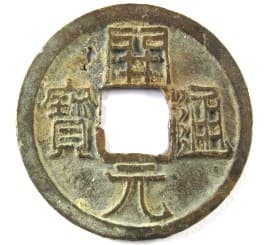
Fortune-Telling and Old Chinese Cash Coins
Traditional Methods of Fortune-Telling
In ancient times, the Chinese
believed in consulting a fortune-teller for both important and
mundane matters. For example, a Chinese might have
wanted to know if he would be successful in his
business. Or, he might have wanted to know if he would
pass the imperial
examinations, have
children, be cured of an
illness, etc.
In old China, fortune-tellers mainly relied on the following methods to foretell the future:
- using a horoscope and reference to the five elements and the
12 animals of the Chinese zodiac
- using physiognomy (observing the eyes, eyebrows, nose, mouth, ears, lips, teeth, etc) and palm-reading
- using a little bird to select from 64 slips of paper with poetry and pictures of gods and animals
- having the customer select from various sheets of paper on which were written Chinese characters and then dissecting the various components of the characters
- fengshui
- using three old Chinese cash coins and a tortoise shell
Using Old Cash Coins and a Tortoise Shell
The method of using three
old Chinese cash coins and a tortoise shell to predict the
future was as follows.
 Fortune-tellers
preferred using old cash coins from
the Tang Dynasty (618 - 907 AD) such as the kai yuan tong bao
(开元通宝), pictured here, first cast in the year 621 AD
during the reign of Emperor Gao Zu.
Fortune-tellers
preferred using old cash coins from
the Tang Dynasty (618 - 907 AD) such as the kai yuan tong bao
(开元通宝), pictured here, first cast in the year 621 AD
during the reign of Emperor Gao Zu.
The fortune-teller would first light incense and candles and place them in front of a picture of an old man whom they considered a deity of this kind of divination. He would then put three cash coins into a tortoise shell, shake them and spill them out onto a plate. After observing how many of the coins were reverse side up he would then use the coins to rap on the tortoise shell.
The process of shaking the coins in the tortoise shell, spilling them out, observing the number of coins reverse side up, and then rapping on the tortoise shell was repeated three times.
The fortune-teller would then use a complicated set of rules and compare the position of the coins with the five elements and the bagua to make his prognostication.
Of the six methods of fortune-telling mentioned above, the literary class of Chinese considered this method to be the most orthodox and reliable.
Note: To see how old Chinese cash coins were also used to treat illness and disease, please visit Chinese Coins and Traditional Chinese Medicine.
Return to Ancient Chinese Charms and Coins
 Fortune-tellers
preferred using old cash coins from
the Tang Dynasty (618 - 907 AD) such as the kai yuan tong bao
(开元通宝), pictured here, first cast in the year 621 AD
during the reign of Emperor Gao Zu.
Fortune-tellers
preferred using old cash coins from
the Tang Dynasty (618 - 907 AD) such as the kai yuan tong bao
(开元通宝), pictured here, first cast in the year 621 AD
during the reign of Emperor Gao Zu.The fortune-teller would first light incense and candles and place them in front of a picture of an old man whom they considered a deity of this kind of divination. He would then put three cash coins into a tortoise shell, shake them and spill them out onto a plate. After observing how many of the coins were reverse side up he would then use the coins to rap on the tortoise shell.
The process of shaking the coins in the tortoise shell, spilling them out, observing the number of coins reverse side up, and then rapping on the tortoise shell was repeated three times.
The fortune-teller would then use a complicated set of rules and compare the position of the coins with the five elements and the bagua to make his prognostication.
Of the six methods of fortune-telling mentioned above, the literary class of Chinese considered this method to be the most orthodox and reliable.
Note: To see how old Chinese cash coins were also used to treat illness and disease, please visit Chinese Coins and Traditional Chinese Medicine.
Return to Ancient Chinese Charms and Coins